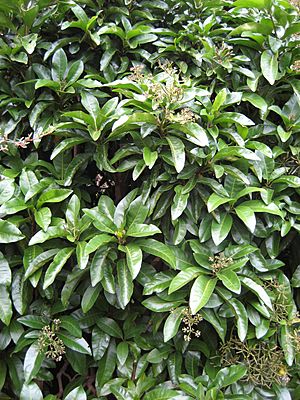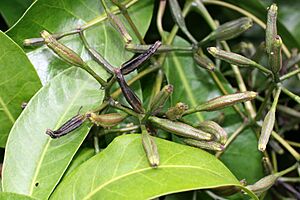Pisonia brunoniana facts for kids
Quick facts for kids Pisonia brunoniana |
|
|---|---|
 |
|
| Scientific classification | |
| Genus: |
Pisonia
|
| Species: |
brunoniana
|
| Synonyms | |
|
Pisonia sinclairii Hook.f. |
|
The parapara (scientific name: Pisonia brunoniana) is a type of flowering tree. It belongs to the Nyctaginaceae family. You can find this tree naturally growing in New Zealand, Norfolk Island, Lord Howe Island, and Hawaiʻi. In New Zealand, people often call it the parapara or the birdcatcher tree.
Contents
What is the Parapara Tree Like?
The parapara is a small tree. It can grow to be about 6 metres (20 ft) tall or even more. Its wood is soft, and its branches can break easily.
Leaves, Flowers, and Fruits
The leaves of the parapara tree are large and shiny. They grow in pairs or in groups of three. The edges of the leaves are smooth, and their tips are rounded.
The tree produces many flowers in clusters. These flowers are either male or female. After the flowers, the tree grows very sticky fruits. These fruits are long and narrow, about 2–3 centimetres (0.79–1.18 in) in length. They have five ridges along their sides.
Why is it Called the Birdcatcher Tree?
The fruits of the parapara tree are so sticky that small birds can sometimes get caught in them. This is how the tree got its nickname, the "birdcatcher tree."
A similar tree, Pisonia grandis, grows in the Seychelles. Its sticky seeds can also trap seabirds. Scientists think these sticky seeds help the tree spread. Birds might carry the seeds on their feathers to new islands. The same might be true for the parapara tree.
Where Does the Parapara Tree Grow?
In New Zealand, the parapara tree grows along the coast. You can find it on Raoul Island in the Kermadec group. It also grows on the Three Kings Islands.
Parapara in New Zealand's North Island
On New Zealand's North Island, the tree is found in a few places. These include areas from Whangape Harbour to Mangawhai. In the past, it grew near Auckland, on the Coromandel Peninsula, and at East Cape.
Today, the parapara tree is mostly found on small islands off the coast. These islands often do not have rodents. On these islands, the parapara is an important part of the forest.
Why is it Rare in Some Areas?
The parapara tree is almost gone from the North Island. This is partly because animals like possums, goats, and wild cattle love to eat its large leaves.
You can still find the parapara tree grown as a decorative plant in New Zealand. It is especially popular in the northern North Island. There are also two types of parapara trees with patterned leaves sold in nurseries. One of these might actually be a different, but similar, species called P. umbellifera.
Parapara in Hawaiʻi
In Hawaiʻi, the parapara tree is known as pāpala kēpau. It grows best in dry or moderately wet areas. While it is common in some spots, like Kīpuka Puaulu, it is not as widespread as other similar trees.
How Hawaiians Used the Sticky Fruits
Long ago, Hawaiian kia manu (bird catchers) used the sticky fruits of the pāpala kēpau. They would use the sticky sap to trap birds. This allowed them to collect feathers. These feathers were then used to make beautiful capes and other special items.
External Links
- Pisonia brunoniana on Flora of Australia Online
- Papala kepau on Hawaiian Ethnobotany Online Database, Bishop Museum
- Pisonia brunoniana on New Zealand Plant Conservation Network
- Papala kepau on Plants of Hawaii


